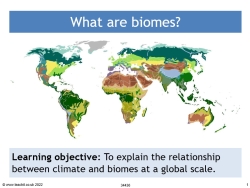What are biomes?

A complete lesson for KS3 or KS4 students which introduces them to the following biomes: taiga, tropical rainforest, hot semi-arid grassland, tundra, desert, temperate deciduous forest.
Students gather facts about the biomes from information stations around the classroom and use these facts to answer questions on the relationship between climate and biomes. They also consider the adaptations of a key plant and animal to the conditions in each biome.
The PowerPoint contains a key word matching starter activity, success criteria for the information-gathering task, a progress check and a true/false plenary. A challenge grid is included, and this can be used either for retrieval practice in a later lesson or for homework, or as a classroom activity.
Adaptations to the taiga biome:
Snowshoe hare
- The hare has large hind legs to help it move through the snow.
- It has thick fur to enable it to stay warm.
- The fur changes colour throughout the year depending on the season. It is white in winter and red/brown in spring.
- The hare has a varied diet depending on what is available at the time of year.
Black spruce tree
- Evergreen – does not shed its leaves in the winter. This uses less energy than regrowing leaves in the spring.
- It has waxy needles which reduce evapotranspiration.
- It has thick bark to protect it against the cold.
- The branches are short and drooping to prevent snow build-up.
